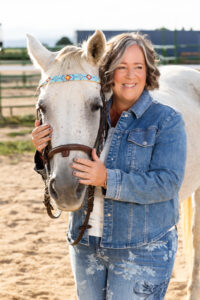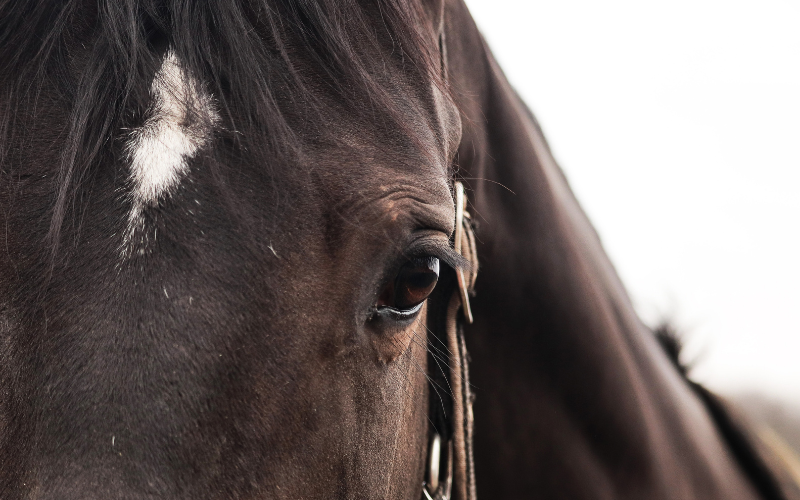July 15 is “I Love Horses” day, the perfect time to celebrate the importance of horses in Equine Assisted EMDR Therapy.
Healing in Motion: Insights from Equine-Assisted EMDR With a Neurodivergent Youth
Guest Blog Post by Elizabeth Warson, PhD, ATR-BC, LPC
 In trauma recovery, healing often occurs through the body before it can be expressed in words. For individuals with neurodevelopmental differences, like Autism Spectrum Disorder (ASD), somatic and experiential therapies offer particularly potent avenues for integration and growth. Over the course of 10 Equine-Assisted Eye Movement Desensitization and Reprocessing (EMDR) therapy sessions, a 10-year-old Indigenous client diagnosed with ASD demonstrated profound healing movements through an approach that blended bilateral stimulation, relational attunement, and body-based resourcing—all within the dynamic partnership of horse and human using EquiLateral™ Protocol (Jenkins, 2022).
In trauma recovery, healing often occurs through the body before it can be expressed in words. For individuals with neurodevelopmental differences, like Autism Spectrum Disorder (ASD), somatic and experiential therapies offer particularly potent avenues for integration and growth. Over the course of 10 Equine-Assisted Eye Movement Desensitization and Reprocessing (EMDR) therapy sessions, a 10-year-old Indigenous client diagnosed with ASD demonstrated profound healing movements through an approach that blended bilateral stimulation, relational attunement, and body-based resourcing—all within the dynamic partnership of horse and human using EquiLateral™ Protocol (Jenkins, 2022).
Early engagement and somatic connection: Sessions 1–3
In the initial sessions, the client actively engaged with the horse through tactile, proprioceptive, and vestibular experiences. Activities included braiding the horse’s mane, riding bareback, and experimenting with novel seated positions, all of which provided critical sensory input. These embodied interactions support nervous system regulation, a foundational need for individuals with ASD (Grandin, 2022).
Positive emotional states, such as “confidence” and “pride,” were resourced early through bilateral tapping integrated with horseback movement, a key intervention strategy emphasized in EquiLateral™ (Jenkins, 2022).
Dysregulation and emerging boundaries: Sessions 4–6
By the middle of the intervention period, patterns of dysregulation surfaced, often linked to interpersonal conflict narratives involving family members. Resistance, expressed through repeated “No” responses, indicated a healthy exploration of boundary setting, a critical developmental task in trauma recovery (Porges & Dana, 2018).
Despite emotional challenges, the client maintained somatic connection strategies: gripping the mane, switching physical orientations on the horse, and using movement to self-soothe. These behaviors align with current polyvagal-informed approaches emphasizing co-regulation through safe, embodied engagement (Porges & Dana, 2018).
Play, boredom, and trauma symbolism: Sessions 7–9
Later sessions revealed expressions of boredom alongside increased impulsivity and imaginative play. The client’s development of a self-initiated “rollercoaster” tapping pattern across the horse’s neck offered a powerful example of spontaneous bilateral self-regulation.
Fascination with rodeo gestures, risk-taking behaviors, and statements like “I almost died out there” pointed to symbolic trauma reenactment—an expected and reparative part of trauma integration when approached through nonverbal, play-based channels (van der Kolk, 2015; Jenkins, 2022).
Closure and resilience: Session 10
The final session reflected both the culmination of internalized somatic resources and the ongoing challenges of emotional regulation. Despite moments of impulsivity and social distraction, the client instinctively returned to her bilateral tapping at critical junctures, grounding herself three times independently.
This ability to access a body-based, self-directed regulation strategy signifies a major therapeutic accomplishment, especially for clients with ASD who often struggle with interoceptive awareness and emotional modulation (Grandin, 2022).
Thematic analysis
Somatic resourcing and self-regulation
Throughout the sessions, the client developed and maintained spontaneous somatic regulation techniques, including bilateral tapping, tactile engagement (e.g., mane holding), and adjusting her physical position for comfort. These skills are emphasized in Jenkins’ EquiLateral™ protocol (2022), which integrates EMDR’s structured phases into equine environments to enhance safety and somatic processing.
Sensory-seeking and exploration
The client’s active sensory exploration, through barefoot riding, braiding, and positional play, reflects the importance of multisensory integration in trauma-informed equine work. Sensory-rich, movement-based experiences offer pathways for neuroplastic repair and emotional resilience (van der Kolk, 2015; Grandin, 2022).
Emotional expression and conflict navigation
Verbalizations of emotional states—ranging from “confident” to “bored”—along with spontaneous boundary testing (“No!” responses) demonstrated healthy development of emotional awareness and agency. Current research emphasizes the importance of allowing authentic emotional expression within safe relational fields to facilitate trauma resolution (Dana, 2021).
Attachment and relational safety
Attachment patterns were evident through the client’s deepening connection with the horses, her preference for specific horses, and her physical gestures of bonding (e.g., leaning into the mane). These behaviors mirror safe attachment repair strategies where consistent, nonjudgmental animal relationships provide corrective emotional experiences (Schore, 2019).
Symbolic trauma processing
The client’s emulation of rodeo gestures and narratives of danger (“I almost died”) revealed important somatic and symbolic representations of unprocessed trauma. Equine-Assisted EMDR provided a flexible framework for containing and supporting these reenactments within a relationally and physically grounded environment (Jenkins, 2022).
Meeting clients where they are
Equine-Assisted EMDR, guided by structured protocols like EquiLateral™, offers a deeply embodied, relationally rich pathway for trauma healing, especially for youth with neurodevelopmental differences.
In this case, the client’s journey—from joyful engagement, through emotional dysregulation, into self-generated resilience strategies—highlights the capacity of the human–horse relationship to unlock healing processes that conventional talk therapy alone may not reach.
As the field of trauma therapy continues to evolve, experiential models like Equine-Assisted EMDR will remain essential for meeting clients where they are: in their bodies, in their nervous systems, and in connection – with themselves, with others, and with the living world around them.
Elizabeth Warson, PhD, ATR-BC, LPC, NCC, EXAT, EAP II and EMDRIA Approved Consultant™ integrates EMDR, expressive arts, and equine-assisted therapy. Warson is a clinician, educator, and researcher at Healing Pathways LLC, with a focus on culturally responsive, trauma-informed care, polyvagal theory, and indigenous health interventions through expressive and somatic-based practices.
References and Resources
Dana, D. (2021). Anchored: How to Befriend Your Nervous System Using Polyvagal Theory. Sounds True.
Grandin, T. (2022). Visual Thinking: The Hidden Gifts of People Who Think in Pictures, Patterns, and Abstractions. Riverhead Books.
Jenkins, S. (2022). Equilateral: The Equine-Assisted EMDR Protocol®. [Manual].
Porges, S. W., & Dana, D. (2018). Clinical Applications of the Polyvagal Theory: The Emergence of Polyvagal-Informed Therapies. W.W. Norton & Company.
Schore, A. N. (2019). Right Brain Psychotherapy. W.W. Norton & Company.
van der Kolk, B. A. (2015). The Body Keeps the Score: Brain, Mind, and Body in the Healing of Trauma. Penguin Books.
The Weld Foundation. https://weldcommunityfoundation.org/
Back to Focal Point Blog Homepage
Additional Resources
If you are a therapist interested in the EMDR training:
- Learn more about EMDR therapy at the EMDRIA Library
- Learn more about EMDR Training
- Search for an EMDR Training Provider
- Check out our EMDR Training FAQ
If you are EMDR trained:
- Check out the EMDRIA Let’s Talk EMDR Podcast
- Check out the EMDRIA Focal Point Blog
- Learn more about EMDRIA membership
- Search for EMDR Continuing Education opportunities
If you are an EMDRIA™ Member:
- Learn more about EMDR Consultation
- Find clinical practice articles in the EMDRIA Go With That Magazine®
- Search for articles in Journal of EMDR Practice and Research in the EMDRIA Library
Date
July 11, 2025
Contributor(s)
Elizabeth Warson
Topics
ADHD/Autism/Neurodiversity, Attachment
Client Population
Children, Racial/Cultural/Ethnic Groups
Practice & Methods
Animal-Assisted Therapy, Integrative Therapies





